Integrated OFDM Waveform Design for RadCom System-Based Signal-to-Clutter Noise Ratio Maximization
Abstract
1. Introduction
1.1. Background and Motivation
1.2. Related Research Review
1.3. Major Contributions
- An integrated OFDM waveform design for RadCom systems is presented and then posed as an optimization model. The proposed waveform design for RadCom systems is established to maximize the SCNR for the target detection performance of the radar system while fulfilling the specified DIR threshold, which is considered a performance metric for the communication system. As such, the principle concept of this paper is to design an integrated waveform that can improve the detection performance of the radar system.
- We precisely illustrate that the presented integrated OFDM waveform design has been reformulated as an optimization problem. Then, we analytically prove that the objective function is a convex set by deriving the first and second derivatives regarding the integrated transmitted power. The first derivative indicates that the objective function is a monotonically increasing function, while the second derivative states that it is a decreasing function. In addition, the constraints are simplified to be affine functions. Accordingly, the derived optimization problem is convex. Consequently, the solution procedures are simplified.
- We introduce an optimal solution for the convex optimization problem by applying the Lagrangian multipliers technique. Then, we use the Karush-Kuhn-Tucker (KKT) optimality conditions to find an optimal solution and convert the optimization problem to a nonlinear equation problem (aside from the bisection search algorithm) to propose an efficient waveform design with relatively low computational complexity.
- Various simulation results are presented to demonstrate the effectiveness of the proposed integrated OFDM waveform design for RadCom systems. More specifically, the proposed strategy would provide subcarriers with better channel conditions (the subcarriers which have less noise power), more transmit power. Moreover, it is shown that by implementing the proposed integrated OFDM waveform design, the detection performance of the RadCom system is competently enhanced.
2. System Model and Integrated Signal Model
2.1. System Model
2.2. Integrated Signal Model
2.3. Performance Metrics for Radar and Communication Systems
2.3.1. Radar Detection Performance
2.3.2. Data Information Rate (DIR) Performance
3. Problem Formulation of the Proposed OFDM Waveform Design
3.1. Problem Formulation
3.2. Problem Solution
| Algorithm 1: Integrated OFDM Waveform Design Strategy |
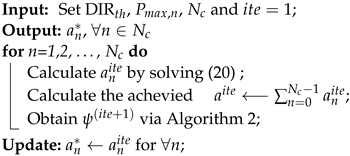 |
| Algorithm 2: Bisection Method Algorithm for |
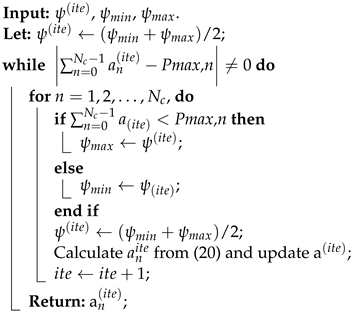 |
4. Simulation Results and Performance Analysis
4.1. Numerical Set-Up
4.2. Waveform Design Results
4.3. Detection Performance Analysis
4.4. Computation Complexity
5. Discussion
6. Conclusions
Author Contributions
Funding
Institutional Review Board Statement
Informed Consent Statement
Data Availability Statement
Conflicts of Interest
Abbreviations
| UHF | Ultra-high Frequency |
| LTE | Long-term Evolution |
| RadCom | Integrated Radar and Communication (RadCom) Systems |
| DFRC | Dual-function Radar-communication System |
| JRC | Joint Communication and Radar |
| MIMO | Multiple-input and Multiple-output |
| SCNR | Signal-to-clutter Noise Ratio |
| DIR | Data Information Rate |
| OFDM | Orthogonal Frequency Division Multiplexing |
| ITS | Intelligent Transportation System |
| IoV | Internet of Vehicles |
| IoT | Internet of Things |
| LFM | Linear Frequency Modulation |
| FFT | Fast Fourier Transform |
| SNR | Signal-to-noise Ratio |
| PAPR | Peak-to-average Power Ratio |
| PMERP | Peak-to-mean Envelope Power Ratio |
| CMI | Conditional Mutual Information |
References
- Griffiths, H.; Blunt, S.; Cohen, L.; Savy, L. Challenge problems in spectrum engineering and waveform diversity. In Proceedings of the 2013 IEEE Radar Conference (RadarCon13), Ottawa, ON, Canada, 29 April–3 May 2013; pp. 1–5. [Google Scholar]
- Blunt, S.; Cook, M.; Stiles, J. Embedding information into radar emissions via waveform implementation. In Proceedings of the 2010 International Waveform Diversity And Design Conference, Niagara Falls, ON, Canada, 8–13 August 2010; pp. 195–199. [Google Scholar]
- Kumar, S.; Costa, G.; Kant, S.; Flemming, B.; Marchetti, N.; Mogensen, P. Spectrum sharing for next generation wireless communication networks. In Proceedings of the 2008 First International Workshop On Cognitive Radio And Advanced Spectrum Management, Aalborg, Denmark, 14 February 2008; pp. 1–5. [Google Scholar]
- Zhou, Y.; Zhou, H.; Zhou, F.; Wu, Y.; Leung, V. Resource allocation for a wireless powered integrated radar and communication system. IEEE Wirel. Commun. Lett. 2018, 8, 253–256. [Google Scholar] [CrossRef]
- Mohammad, M.; Cui, G.; Yu, X.; Ahmed, M.; Gemechu, A. Power allocation strategy for OFDM waveform in RadCom systems. In Proceedings of the 2020 IEEE 11th Sensor Array And Multichannel Signal Processing Workshop (SAM), Hangzhou, China, 8–11 June 2020; pp. 1–5. [Google Scholar]
- Shi, C.; Wang, F.; Salous, S.; Zhou, J. Low probability of intercept-based radar waveform design for spectral coexistence of distributed multiple-radar and wireless communication systems in clutter. Entropy 2018, 20, 197. [Google Scholar] [CrossRef] [PubMed]
- Sturm, C.; Wiesbeck, W. Waveform design and signal processing aspects for fusion of wireless communications and radar sensing. Proc. IEEE 2011, 99, 1236–1259. [Google Scholar] [CrossRef]
- Shi, C.; Wang, F.; Salous, S.; Zhou, J. Low probability of intercept-based optimal OFDM waveform design strategy for an integrated radar and communications system. IEEE Access 2018, 6, 57689–57699. [Google Scholar] [CrossRef]
- Liu, F.; Masouros, C.; Ratnarajah, T.; Petropulu, A. On range sidelobe reduction for dual-functional radar-communication waveforms. IEEE Wirel. Commun. Lett. 2020, 9, 1572–1576. [Google Scholar] [CrossRef]
- Yuan, W.; Liu, F.; Masouros, C.; Yuan, J.; Ng, D.; González-Prelcic, N. Bayesian predictive beamforming for vehicular networks: A low-overhead joint radar-communication approach. IEEE Trans. Wirel. Commun. 2020, 20, 1442–1456. [Google Scholar] [CrossRef]
- Wild, T.; Braun, V.; Viswanathan, H. Joint design of communication and sensing for beyond 5G and 6G systems. IEEE Access 2021, 9, 30845–30857. [Google Scholar] [CrossRef]
- Huang, Y.; Ye, Q.; Hu, Z.; Liu, J.; Hu, S.; Zhang, Z. Partially-Reserved Cyclic Algorithm For OFDM-Based RadCom PAPR Reduction. Procedia Comput. Sci. 2022, 202, 436–448. [Google Scholar] [CrossRef]
- Moghaddasi, J.; Wu, K. Multifunctional transceiver for future radar sensing and radio communicating data-fusion platform. IEEE Access 2016, 4, 818–838. [Google Scholar] [CrossRef]
- Saddik, G.; Singh, R.; Brown, E. Ultra-wideband multifunctional communications/radar system. IEEE Trans. Microw. Theory Tech. 2007, 55, 1431–1437. [Google Scholar] [CrossRef]
- Sit, Y.; Zwick, T. MIMO OFDM radar with communication and interference cancellation features. In Proceedings of the 2014 IEEE Radar Conference, Cincinnati, OH, USA, 19–23 May 2014; pp. 265–268. [Google Scholar]
- Liu, Y.; Liao, G.; Yang, Z.; Xu, J. Joint range and angle estimation for an integrated system combining MIMO radar with OFDM communication. Multidimens. Syst. Signal Process. 2019, 30, 661–687. [Google Scholar] [CrossRef]
- Liu, Y.; Liao, G.; Yang, Z. Range and angle estimation for MIMO-OFDM integrated radar and communication systems. In Proceedings of the 2016 CIE International Conference On Radar (RADAR), Guangzhou, China, 10–13 October 2016; pp. 1–4. [Google Scholar]
- Rahmatallah, Y.; Mohan, S. Peak-to-average power ratio reduction in OFDM systems: A survey and taxonomy. IEEE Commun. Surv. Tutorials 2013, 15, 1567–1592. [Google Scholar] [CrossRef]
- Jankiraman, M.; Wessels, B.; Van Genderen, P. Design of a multifrequency FMCW radar. In Proceedings of the 1998 28th European Microwave Conference, Amsterdam, The Netherlands, 5–9 October 1998; Volume 1, pp. 584–589. [Google Scholar]
- Sturm, C.; Zwick, T.; Wiesbeck, W. An OFDM system concept for joint radar and communications operations. In Proceedings of the VTC Spring 2009-IEEE 69th Vehicular Technology Conference, Barcelona, Spain, 26–29 April 2009; pp. 1–5. [Google Scholar]
- Rong, J.; Liu, F.; Miao, Y. Integrated Radar and Communications Waveform Design Based on Multi-Symbol OFDM. Remote Sens. 2022, 14, 4705. [Google Scholar] [CrossRef]
- Liu, Y.; Liao, G.; Yang, Z. Robust OFDM integrated radar and communications waveform design based on information theory. Signal Process. 2019, 162, 317–329. [Google Scholar] [CrossRef]
- Ahmed, A.; Zhang, Y.; Hassanien, A. Joint radar-communications exploiting optimized OFDM waveforms. Remote Sens. 2021, 13, 4376. [Google Scholar] [CrossRef]
- Han, L.; Wu, K. Multifunctional transceiver for future intelligent transportation systems. IEEE Trans. Microw. Theory Tech. 2011, 59, 1879–1892. [Google Scholar] [CrossRef]
- Liu, Y.; Liao, G.; Yang, Z.; Xu, J. Design of integrated radar and communication system based on MIMO-OFDM waveform. J. Syst. Eng. Electron. 2017, 28, 669–680. [Google Scholar]
- Paul, B.; Chiriyath, A.; Bliss, D. Survey of RF communications and sensing convergence research. IEEE Access 2016, 5, 252–270. [Google Scholar] [CrossRef]
- Chiriyath, A.; Paul, B.; Jacyna, G.; Bliss, D. Inner bounds on performance of radar and communications co-existence. IEEE Trans. Signal Process. 2015, 64, 464–474. [Google Scholar] [CrossRef]
- Chiriyath, A.; Paul, B.; Bliss, D. Radar-communications convergence: Coexistence, cooperation, and co-design. IEEE Trans. Cogn. Commun. Netw. 2017, 3, 1–12. [Google Scholar] [CrossRef]
- Huang, Y.; Hu, S.; Ma, S.; Liu, Z.; Xiao, M. Designing low-PAPR waveform for OFDM-based RadCom systems. IEEE Trans. Wirel. Commun. 2022, 21, 6979–6993. [Google Scholar] [CrossRef]
- Li, C.; Bao, W.; Xu, L.; Zhang, H.; Huang, Z. Radar communication integrated waveform design based on OFDM and circular shift sequence. Math. Probl. Eng. 2017, 2017, 9840172. [Google Scholar] [CrossRef]
- Chen, Y.; Liao, G.; Liu, Y.; Li, H.; Liu, X. Joint Subcarrier and Power Allocation for Integrated OFDM Waveform in RadCom Systems. IEEE Commun. Lett. 2023, 27, 253. [Google Scholar] [CrossRef]
- Hsu, H.; Lee, M.; Gu, M.; Lin, Y.; Lee, T. Analysis and design for pilot power allocation and placement in OFDM based integrated radar and communication in automobile systems. IEEE Trans. Veh. Technol. 2021, 71, 1519–1535. [Google Scholar] [CrossRef]
- Amin, A.; Liu, X.; Khan, I.; Uthansakul, P.; Forsat, M.; Mirjavadi, S. A Robust Resource Allocation Scheme for Device-to-Device Communications Based on Q-Learning; Tech Science Press: Henderson, NV, USA, 2020. [Google Scholar]
- Tian, X.; Zhang, T.; Zhang, Q.; Song, Z. Waveform design and processing in OFDM based radar-communication integrated systems. In Proceedings of the 2017 IEEE/CIC International Conference On Communications In China (ICCC), Qingdao, China, 22–24 October 2017; pp. 1–6. [Google Scholar]
- Liu, Y.; Liao, G.; Xu, J.; Yang, Z.; Zhang, Y. Adaptive OFDM integrated radar and communications waveform design based on information theory. IEEE Commun. Lett. 2017, 21, 2174–2177. [Google Scholar] [CrossRef]
- Wu, H.; Jin, B.; Xu, Z.; Zhu, X.; Zhang, Z.; Lian, Z. Waveform design and signal processing for integrated radar-communication system based on frequency diversity array. Digit. Signal Process. 2023, 133, 103839. [Google Scholar] [CrossRef]
- Gu, Y.; Zhang, L.; Zhou, Y.; Zhang, Q. Waveform design for integrated radar and communication system with orthogonal frequency modulation. Digit. Signal Process. 2018, 83, 129–138. [Google Scholar] [CrossRef]
- Xie, Y.; Tao, R.; Wang, T. Method of waveform design for radar and communication integrated system based on CSS. In Proceedings of the 2011 First International Conference On Instrumentation, Measurement, Computer, Communication and Control, Beijing, China, 21–23 October 2011; pp. 737–739. [Google Scholar]
- Gao, J.; Wu, R.; Zhang, J. An adaptive multi-target jamming waveform design based on power minimization. Entropy 2020, 22, 508. [Google Scholar] [CrossRef]
- Khelouani, I.; Elbahhar, F.; Elassali, R.; Idboufker, N. Performance Evaluation of 5G Waveforms for Joint Radar Communication over 77 GHz and 24 GHz ISM Bands. Energies 2022, 15, 2049. [Google Scholar] [CrossRef]
- Liu, Y.; Wei, Z.; Yan, C.; Feng, Z.; Stüber, G. Effective capacity based power allocation for the coexistence of an integrated radar and communication system and a commercial communication system. IEEE Access 2020, 8, 58629–58644. [Google Scholar] [CrossRef]
- Huang, K.; Bică, M.; Mitra, U.; Koivunen, V. Radar waveform design in spectrum sharing environment: Coexistence and cognition. In Proceedings of the 2015 IEEE Radar Conference (RadarCon), Arlington, VA, USA, 10–15 May 2015; pp. 1698–1703. [Google Scholar]
- Shi, C.; Wang, F.; Sellathurai, M.; Zhou, J.; Salous, S. Power minimization-based robust OFDM radar waveform design for radar and communication systems in coexistence. IEEE Trans. Signal Process. 2017, 66, 1316–1330. [Google Scholar] [CrossRef]
- Shi, C.; Salous, S.; Wang, F.; Zhou, J. Low probability of intercept-based adaptive radar waveform optimization in signal-dependent clutter for joint radar and cellular communication systems. EURASIP J. Adv. Signal Process. 2016, 2016, 1–13. [Google Scholar] [CrossRef] [PubMed]
- Turlapaty, A.; Jin, Y. A joint design of transmit waveforms for radar and communications systems in coexistence. In Proceedings of the 2014 IEEE Radar Conference, Cincinnati, OH, USA, 19–23 May 2014; pp. 315–319. [Google Scholar]
- Steven, M. Fundamentals of Statistical Signal Processing; PTR Prentice-Hall: Englewood Cliffs, NJ, USA, 1993; Volume 10, p. 151045. [Google Scholar]
- Tang, B.; Tang, J. Robust waveform design of wideband cognitive radar for extended target detection. In Proceedings of the 2016 IEEE International Conference On Acoustics, Speech And Signal Processing (ICASSP), Shanghai, China, 20–25 March 2016; pp. 3096–3100. [Google Scholar]
- Tang, B.; Huang, Z.; Qin, L.; Wang, H. Fundamental limits on detection with a dual-function radar communication system. arXiv 2022, arXiv:2204.04332. [Google Scholar]
- Boyd, S.; Boyd, S.; Venberghe, L. Convex Optimization; Cambridge University Press: Cambridge, UK, 2004. [Google Scholar]
- Zhou, C.; Gu, Y.; He, S.; Shi, Z. A robust and efficient algorithm for coprime array adaptive beamforming. IEEE Trans. Veh. Technol. 2017, 67, 1099–1112. [Google Scholar] [CrossRef]
- Zhou, C.; Gu, Y.; Zhang, Y.; Shi, Z.; Jin, T.; Wu, X. Compressive sensing-based coprime array direction-of-arrival estimation. Iet Commun. 2017, 11, 1719–1724. [Google Scholar] [CrossRef]
- Romero, R.; Shepherd, K. Friendly spectrally shaped radar waveform with legacy communication systems for shared access and spectrum management. IEEE Access 2015, 3, 1541–1554. [Google Scholar] [CrossRef]
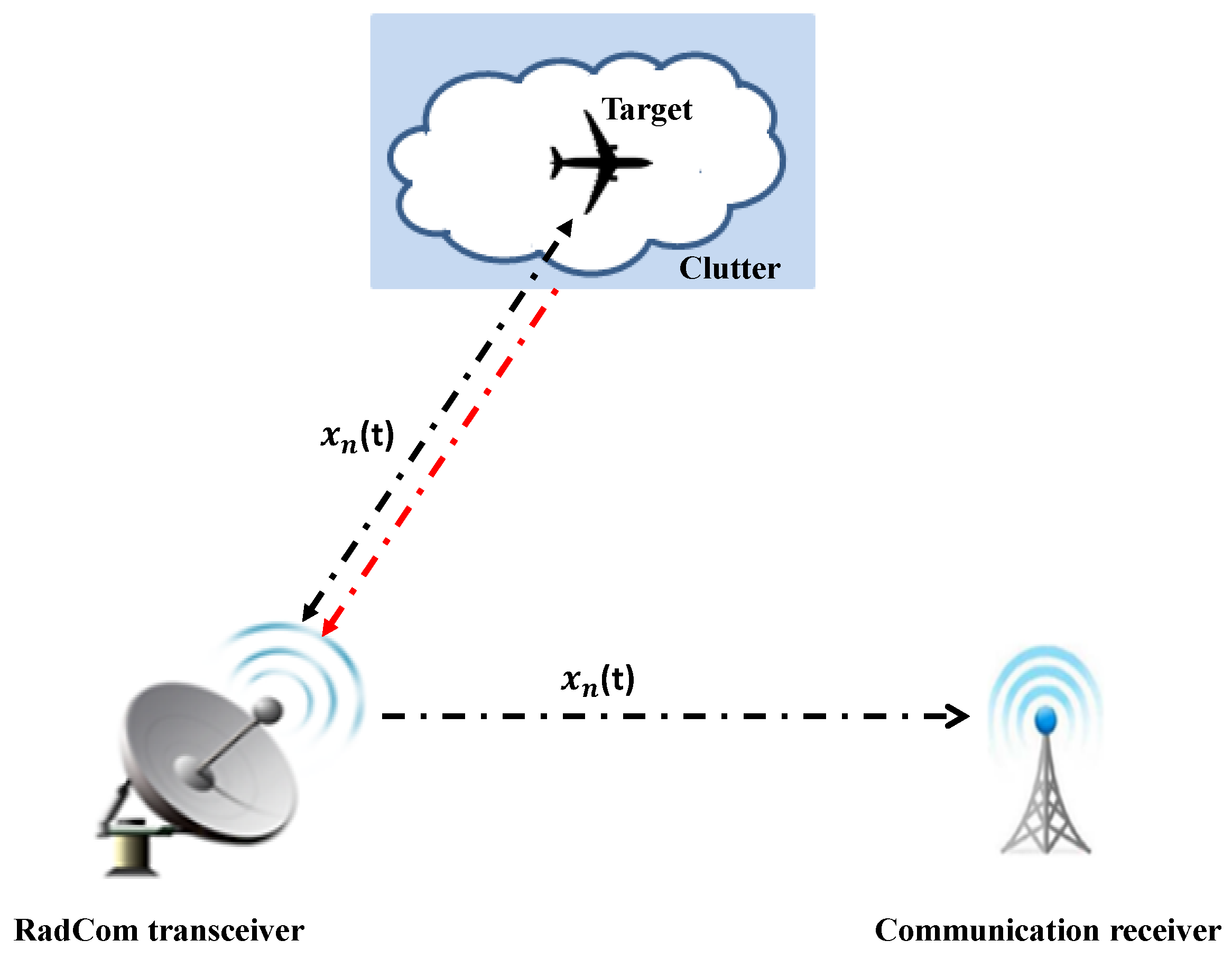
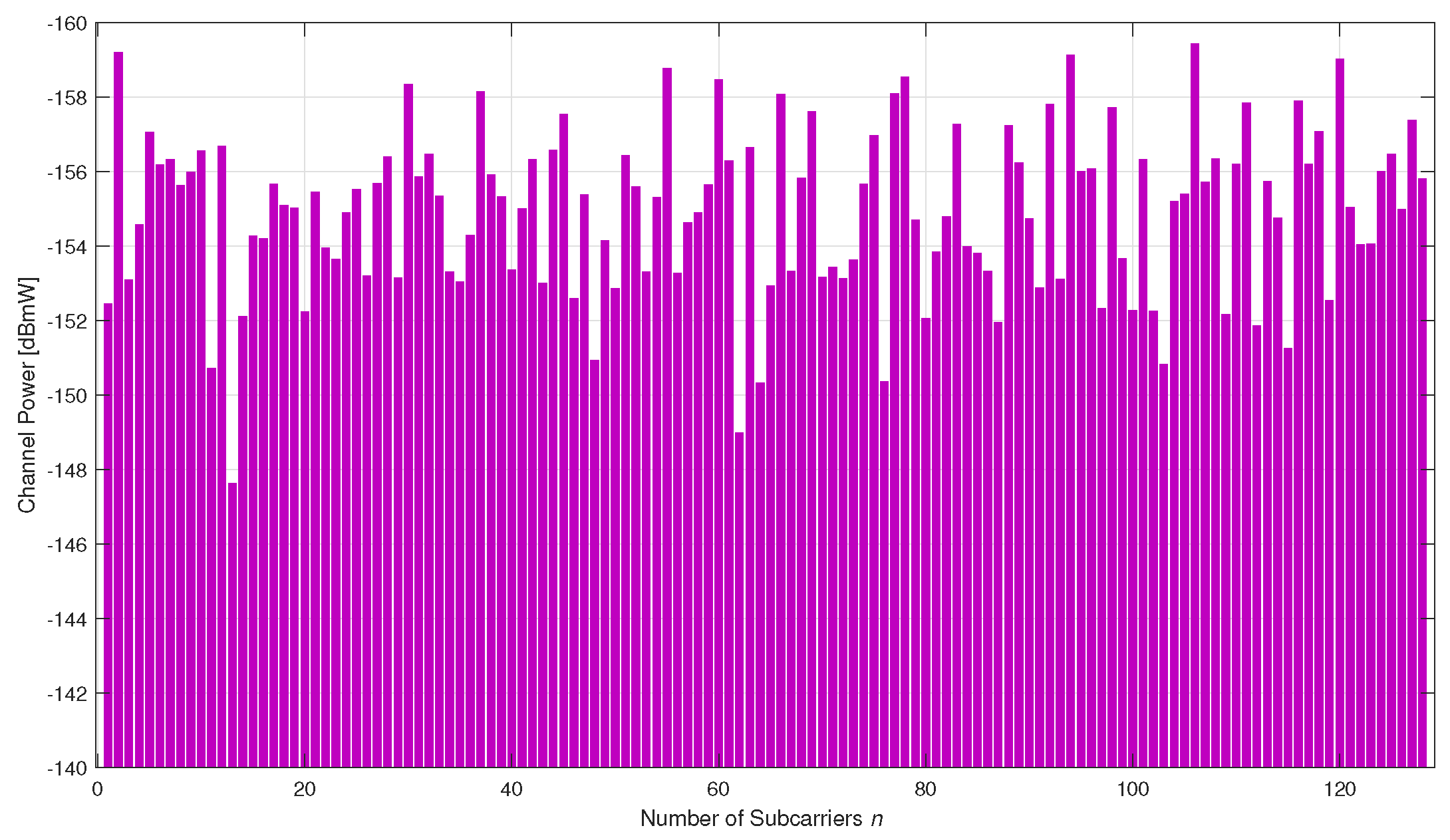

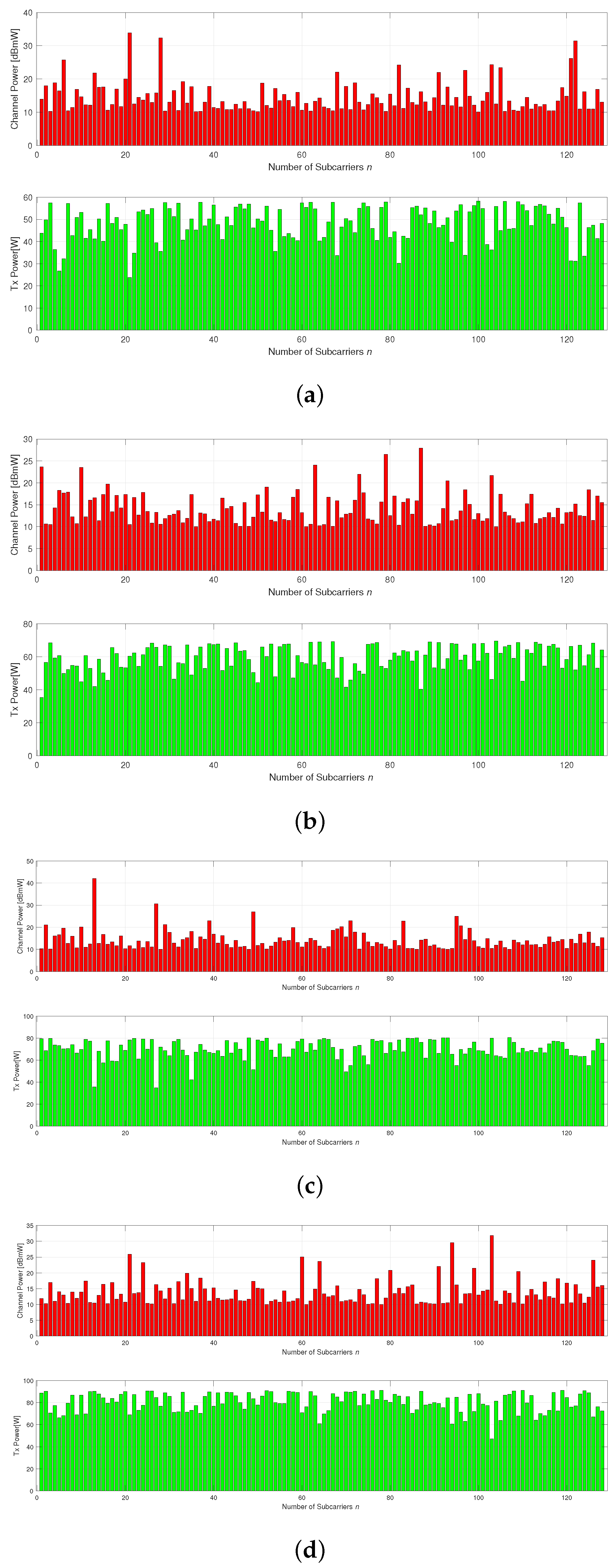

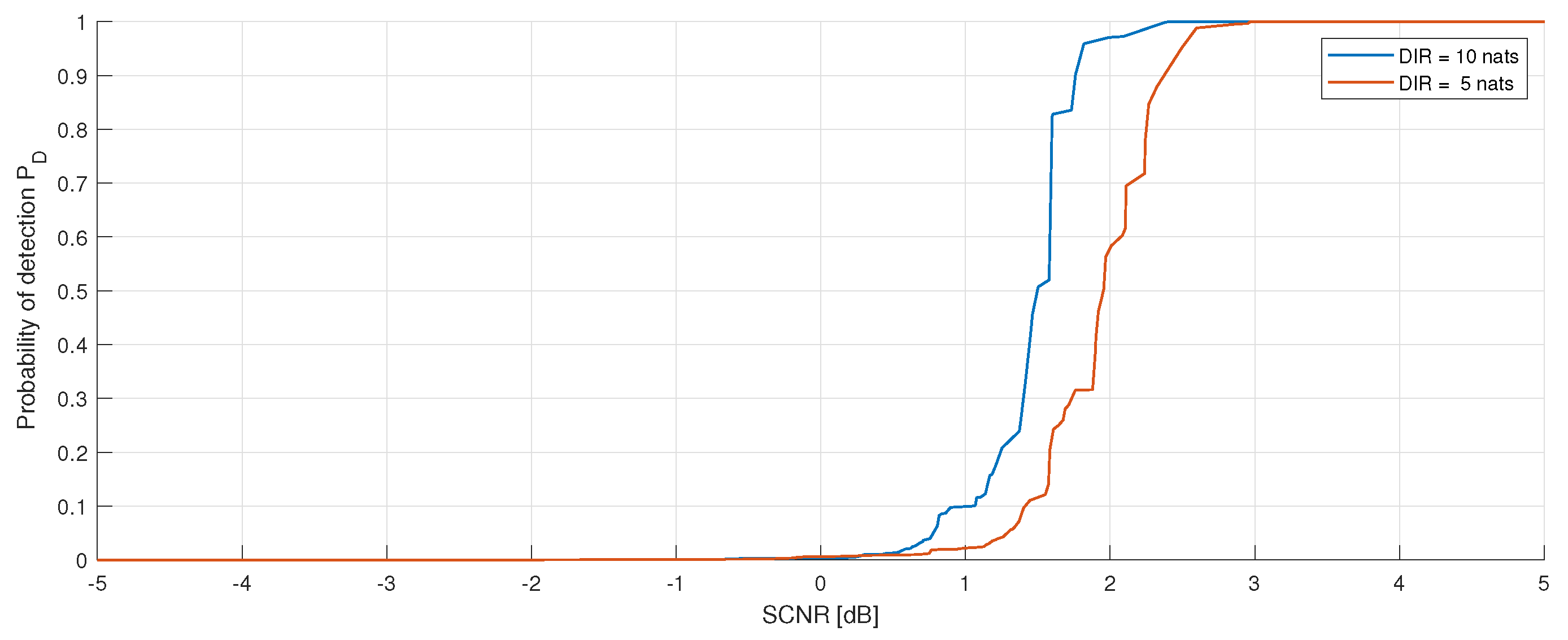
| Parameter | Value | Parameter | Value |
|---|---|---|---|
| 100 km | 10 km | ||
| 30 dB | 30 dB | ||
| 30 dB | 600 W |
Disclaimer/Publisher’s Note: The statements, opinions and data contained in all publications are solely those of the individual author(s) and contributor(s) and not of MDPI and/or the editor(s). MDPI and/or the editor(s) disclaim responsibility for any injury to people or property resulting from any ideas, methods, instructions or products referred to in the content. |
© 2023 by the authors. Licensee MDPI, Basel, Switzerland. This article is an open access article distributed under the terms and conditions of the Creative Commons Attribution (CC BY) license (https://creativecommons.org/licenses/by/4.0/).
Share and Cite
Mohammad, M.A.B.; Cui, G.; Yu, X.; Fakirah, M.; Elhag, N.A.A. Integrated OFDM Waveform Design for RadCom System-Based Signal-to-Clutter Noise Ratio Maximization. Remote Sens. 2023, 15, 3554. https://doi.org/10.3390/rs15143554
Mohammad MAB, Cui G, Yu X, Fakirah M, Elhag NAA. Integrated OFDM Waveform Design for RadCom System-Based Signal-to-Clutter Noise Ratio Maximization. Remote Sensing. 2023; 15(14):3554. https://doi.org/10.3390/rs15143554
Chicago/Turabian StyleMohammad, Mohammad A. B., Guolong Cui, Xianxiang Yu, Maged Fakirah, and Nihad A. A. Elhag. 2023. "Integrated OFDM Waveform Design for RadCom System-Based Signal-to-Clutter Noise Ratio Maximization" Remote Sensing 15, no. 14: 3554. https://doi.org/10.3390/rs15143554
APA StyleMohammad, M. A. B., Cui, G., Yu, X., Fakirah, M., & Elhag, N. A. A. (2023). Integrated OFDM Waveform Design for RadCom System-Based Signal-to-Clutter Noise Ratio Maximization. Remote Sensing, 15(14), 3554. https://doi.org/10.3390/rs15143554







